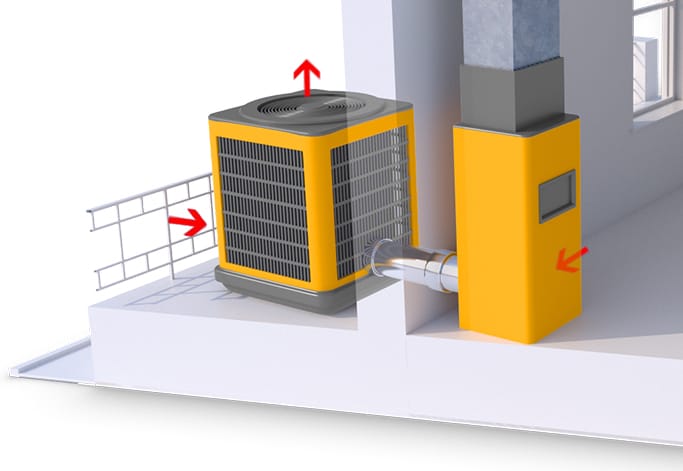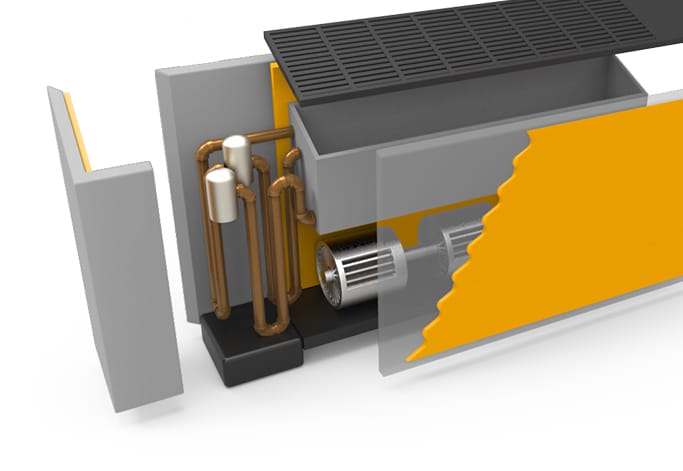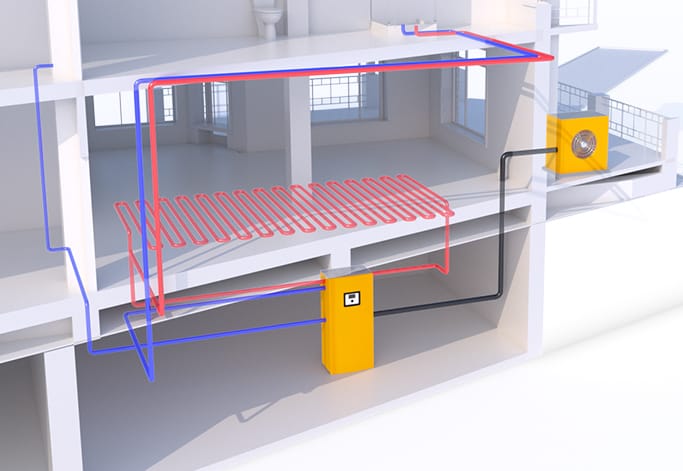What kind of solution do you need?
HVAC (stationary) for residential and light commercial use
HVAC (Heating, Ventilation and Air Conditioning) systems are essential for healthy air and efficient buildings. The HVAC market is flourishing due to an increase in new building construction around the world, as well as a stronger focus on energy standards and legislation.
Market growth and innovation are being driven by energy-efficient technologies such as smart controls, variable speed heat pumps and inverter-type air conditioners. Systems are becoming increasingly integrated and air purifying technologies are also on the rise.
HVAC equipment is classified as either stationary or mobile. Recticel is primarily active in the stationary segment.
HVAC: specific requirements
Recticel works closely with HVAC system manufacturers to design solutions for modern, healthy and energy-efficient buildings. In general, HVAC systems and components must be built to withstand prolonged use, sustained high temperatures, temperature variations, emissions, fire and environmental factors.
Other important design considerations include ease of installation, end-of-life regulations and increasingly stringent energy legislation.
AIR CONDITIONING UNIT
Requirements
ACOUSTIC MATERIAL
• High NRC (Noise Reduction Coefficient) to ensure quiet operation
• Incorporated adhesive facilitates installation
• Available in plates and converted parts
• Product can be delivered in kits for each model
SEALING STRIPS
• Prevent noise passing through gaps
• Avoid loss of cooled/heated air
Applications
In a window air conditioner, all the components (compressor, condenser, expansion valve or coil, evaporator and cooling coil) are enclosed in a single box.
A split air conditioner has two parts: the outdoor unit and the indoor unit. The outdoor unit, fitted outside the room, houses components like the compressor, condenser and expansion valve. The indoor unit contains the evaporator or cooling coil and the cooling fan.
Some homes do not have space inside for a furnace or the coil needed for cooling. A packaged or all-in-one air conditioner houses all its components in the outside unit. This makes it perfect for houses and small commercial buildings with insufficient space for an indoor unit.
HEAT RECOVERY UNIT
Requirements
ACOUSTIC MATERIAL
• High NRC (Noise Reduction Coefficient) to ensure quiet operation
• Incorporated adhesive facilitates installation
• Available in plates and converted parts
• Product can be delivered in kits for each model
SEALING STRIPS
• Prevent noise passing through gaps
• Prevent loss of cooled/heated air
FILTERS
• Prevent water and dust from entering the heat exchanger from the incoming or outgoing stream
Applications
A heat recovery unit (HRU) system provides controlled ventilation with slow but constant air movement. A typical unit features two fans — one to take out household air and the other to bring in fresh air. What makes a HRU system unique is the heat-exchange core. The core transfers heat from the outgoing stream to the incoming stream in the same way that your car’s radiator transfers heat from the engine coolant to the outside air.
UNIT VENTILATOR
Requirements
ACOUSTIC MATERIAL
• High NRC (Noise Reduction Coefficient) to ensure a quiet operation
• Incorporated adhesive facilitates the installation
• Available in plates and converted parts
• Product can be delivered in kits for each model
SEALING STRIPS
• Prevent noise passing through gaps
• Prevent loss of cooled/heated air
Applications
Unit ventilators are used for heating, ventilating and cooling environments, for example classrooms. They are usually installed below the window on the walls, facing outside and consist of a heating coil, fan assembly, dampers, filter and controls housed in a metal cabinet. Outdoor air enters the cabinet through a grille on the outside wall. The unit ventilator mixes the room air with air from outside and heats it if necessary. The air is delivered to the room through a grille in the top of the unit ventilator.
WATER HEATER
Requirements
ACOUSTIC MATERIAL
• High NRC (Noise Reduction Coefficient) to ensure quiet operation
• Incorporated adhesive facilitates installation
• Available in plates and converted parts
• Product can be delivered in kits for each model
SEALING STRIPS
• Prevent noise passing through gaps
Applications
Home owners choose different types of water heaters depending on the size of the house, the available space and the demand for hot water. Tank type water heaters provide a storage tank of constantly hot water. Where there is higher demand for hot water, this type of heater may be more convenient.
Tankless or demand-type water heaters (gas/electric boilers and air/water heat pumps) have no storage tank, but instead heat the water directly. They offer the advantages of lower energy consumption and a smaller unit.Heat pump water heaters provide hot water by using a compressor to move heat from one place to another, rather than generating heat directly. Hot water can also be provided by the sun, using solar water heaters.





